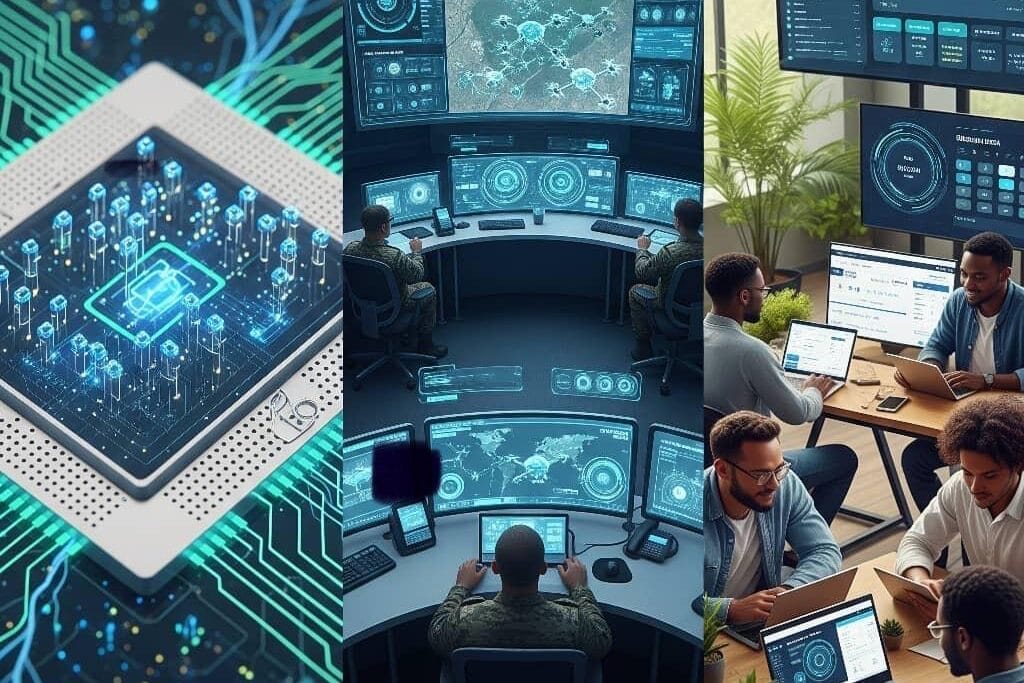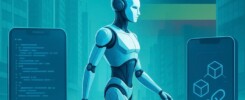By Lauryn Namatovu

Imagine a paralyzed person controlling a computer with their thoughts, military drones coordinating attacks through AI networks, and African entrepreneurs building billion-dollar tech companies while Silicon Valley struggles—this isn’t science fiction, it’s happening right now.
The year 2025 has shattered our expectations of what’s possible. While most of us were still adjusting to the idea of ChatGPT changing how we work, three revolutionary forces have been quietly reshaping the very foundations of human capability, national security, and global innovation. The convergence of brain-computer interfaces, AI-powered defense systems, and Africa’s resilient tech ecosystem isn’t just transforming individual industries—it’s rewriting the rules of what it means to be human in a connected world.
The Neural Revolution: When Minds Meet Machines
From Laboratory Dreams to Operating Room Reality
The brain-computer interface revolution has crossed a threshold that most experts didn’t expect to see until 2030. Neuralink, once dismissed by skeptics as Elon Musk’s most ambitious fantasy, now has three human patients living with brain implants—and they’re not just surviving, they’re thriving.
But here’s what makes this truly extraordinary: the company isn’t just celebrating these early successes; it’s planning to implant 10 times more brain chips in 2025. This represents a leap from 3 patients to potentially 30-50 individuals, marking the transition from experimental medicine to the early stages of clinical deployment.
The Engineering Marvel Inside Your Skull
To understand the magnitude of this achievement, consider what’s actually happening inside each patient’s brain. These aren’t crude electrodes like something from a 1950s science fiction movie. Each Neuralink device is a wireless marvel containing electrode arrays with more than 1,000 ultra-thin, flexible conductors. A surgical robot—yes, a robot—threads these conductors into the cerebral cortex with precision that would make a master surgeon envious.
The implications ripple far beyond the laboratory. We’re talking about restoring autonomy to individuals who have lost the ability to move, speak, or interact with the world around them. Paralyzed patients are already learning to control computers, type messages, and navigate digital interfaces using nothing but their thoughts. This isn’t assistive technology—it’s human augmentation.
The Broader Impact on Medicine and Society
The medical applications extend into territories we’re only beginning to explore. Beyond paralysis, these interfaces could revolutionize treatment for depression, epilepsy, chronic pain, and neurodegenerative diseases. Imagine treating mental health conditions not with pharmaceuticals that affect the entire body, but with precise neural interventions that target specific brain circuits.
But the societal questions are equally profound. As brain-computer interfaces become more sophisticated, we’ll need to grapple with issues of privacy, identity, and human enhancement. If these devices can read thoughts, who owns that data? If they can enhance cognitive abilities, do we create a new class divide between the enhanced and unenhanced?
Defense Tech Revolution: AI Goes to War
The Palantir-Anduril Partnership: More Than Corporate Strategy
While medical breakthroughs capture headlines, a quieter but equally significant revolution is unfolding in defense technology. Palantir Technologies, the data analytics company that helped find Osama bin Laden, has partnered with Anduril Industries, the autonomous systems manufacturer founded by Palmer Luckey, to create something unprecedented: an AI-powered military consortium designed to maintain U.S. technological supremacy.
This isn’t just another defense contract. The partnership integrates Palantir’s sophisticated AI platform with Anduril’s Lattice software, creating a system that can process battlefield data in real-time and coordinate autonomous weapons systems at a scale never before possible.
The Technology Behind Modern Warfare
Anduril’s Lattice represents a fundamental shift in military thinking. It’s a mesh-networking system that enables rapid battlefield data collection and analysis for drone swarms—imagine hundreds of autonomous drones sharing information instantaneously, adapting their tactics based on real-time intelligence, and coordinating attacks without human intervention.
When combined with Palantir’s AI capabilities, which can analyze patterns across massive datasets and predict enemy movements, you get something approaching a military nervous system. The system can identify threats, allocate resources, and execute responses faster than any human commander could process the information.
Lessons from Ukraine: The Future of Conflict
The timing of this partnership isn’t coincidental. The ongoing conflict in Ukraine has demonstrated that modern warfare increasingly depends on information processing speed and autonomous systems. Traditional military hierarchies, with their slow decision-making processes, are proving inadequate against enemies who can adapt and respond in real-time.
Ukrainian forces have successfully used consumer drones modified with AI software to devastating effect against Russian armor. These improvised systems hint at what’s possible when purpose-built autonomous weapons systems are deployed at scale. The Palantir-Anduril partnership represents the U.S. military’s attempt to stay ahead of this curve.
The Civilian Implications
Defense technologies have a history of transitioning to civilian use. The internet began as DARPANET, GPS was originally a military navigation system, and touchscreen technology was developed for military applications. The AI and autonomous systems being developed for military use today will likely find applications in transportation, logistics, emergency response, and countless other civilian sectors.
But this transition also raises ethical questions. As AI systems become more autonomous and capable of making life-and-death decisions without human oversight, we’ll need robust frameworks for accountability and control. The technology being developed to protect national security could also be used to suppress dissent or monitor civilian populations.
Africa Rising: The Continent Defying Global Trends
A Billion-Dollar Story of Resilience
While Silicon Valley grapples with funding freezes and layoffs, something remarkable is happening in Africa. The continent’s startup ecosystem isn’t just surviving the global tech downturn—it’s thriving. African startups raised $1 billion in funding between January and May 2025, representing a 40% jump from the previous year.
This isn’t a statistical anomaly. The first half of 2025 saw 104 African tech startups raise a combined $710.8 million, up 34% from $530 million in the first six months of 2024. While venture capital activity contracts in other regions, Africa is attracting increasing investor interest.
Innovation Born from Necessity
What makes African tech innovation particularly compelling is its practical focus. Unlike Silicon Valley’s tendency toward speculative technologies, African startups are solving immediate, tangible problems. Fintech solutions are providing banking services to populations excluded from traditional financial systems. Agritech companies are addressing food security in regions where more than a third of food is wasted due to poor cold storage infrastructure. Healthtech startups are bringing medical services to areas where the nearest hospital might be hundreds of miles away.
This necessity-driven innovation creates robust, scalable solutions. When you’re building technology for markets with limited infrastructure, unreliable electricity, and low purchasing power, you learn to create systems that are efficient, durable, and cost-effective. These constraints breed innovation in ways that abundance cannot.
The Global Impact of African Innovation
African fintech innovations are already influencing global financial technology. Mobile money systems developed for African markets are being adapted for use in Asia and Latin America. Telemedicine platforms designed for rural African populations are finding applications in underserved American communities. Solar-powered internet systems developed for off-grid African villages are being deployed in disaster-stricken areas worldwide.
The continent’s approach to leapfrogging technology infrastructure offers lessons for developed nations struggling with legacy systems. While American cities debate upgrading century-old electrical grids, African communities are building distributed renewable energy networks from scratch. While European banks struggle with outdated payment systems, African fintech companies are creating digital-first financial infrastructures.
The Talent Pipeline and Brain Circulation
Africa’s tech boom is also creating a reverse brain drain. African engineers and entrepreneurs who might have previously moved to Silicon Valley or London are choosing to stay and build companies on the continent. This talent retention, combined with returnees bringing international experience back to African markets, is creating a virtuous cycle of innovation and expertise.
Universities across the continent are expanding computer science and engineering programs. Coding bootcamps and accelerators are producing skilled developers. International tech companies are establishing African offices not just for market access, but to tap into local talent pools.
The Convergence: Where Three Revolutions Meet
Interconnected Transformation
These three developments—neural interfaces, defense AI, and African tech resilience—aren’t happening in isolation. They represent different facets of a larger transformation in how technology shapes human capability and social organization.
Brain-computer interfaces developed for medical applications could find military uses, enabling soldiers to control weapons systems or communicate silently with AI networks. African innovations in mobile technology and distributed systems could inform the development of resilient military communication networks. Defense technologies for autonomous systems could accelerate the development of brain-computer interface applications.
The Speed of Change
What’s most striking about this moment is the acceleration. Technologies that seemed decades away are being deployed today. The gap between laboratory breakthrough and real-world application is shrinking rapidly. This compression of innovation cycles means we’re likely to see more dramatic changes in the next five years than in the previous twenty.
Global Power Dynamics
These technological developments are also reshaping global power structures. The United States maintains advantages in AI and neural interface technology, but African nations are proving that innovation doesn’t require Silicon Valley infrastructure. China continues to advance in manufacturing and deployment, while European nations grapple with regulatory frameworks that could either enable or constrain technological development.
The countries and regions that adapt most quickly to these changes will likely define the next phase of global economic and political leadership. This isn’t just about having the best technology—it’s about creating the social, economic, and regulatory frameworks that enable rapid technological adoption and adaptation.
Navigating the Transformation
The Challenges Ahead
As we stand at this technological inflection point, we face unprecedented challenges. How do we ensure that brain-computer interfaces enhance human capability without compromising human identity? How do we develop autonomous weapons systems that maintain meaningful human control? How do we support innovation in developing regions without creating new forms of technological dependency?
The Opportunities
But the opportunities are equally unprecedented. We’re approaching solutions to problems that have plagued humanity for centuries. Paralysis might become a temporary condition rather than a permanent disability. Military conflicts might be resolved more quickly and with fewer casualties. Economic development might no longer require following the same path as previous industrialized nations.
The Choices We Make
The future isn’t predetermined by these technologies—it will be shaped by the choices we make about how to develop, deploy, and govern them. The decisions made in boardrooms, laboratories, and government offices today will determine whether these innovations enhance human flourishing or create new forms of inequality and conflict.
Conclusion: The Future is Now
We are living through one of those rare moments in history when the trajectory of human civilization shifts dramatically. The convergence of brain-computer interfaces, AI-powered defense systems, and resilient innovation ecosystems is creating possibilities that would have seemed impossible just a few years ago.
The paralyzed patients controlling computers with their thoughts, the AI systems coordinating military operations, and the African entrepreneurs building billion-dollar companies aren’t glimpses of a distant future—they’re the reality of 2025. The question isn’t whether these technologies will transform society, but how quickly and in what direction.
As we navigate this transformation, we have the opportunity to shape technologies that could eliminate some of humanity’s greatest challenges while creating new possibilities for human flourishing. But we also have the responsibility to ensure that this technological power is developed and deployed wisely.
The future isn’t just arriving—it’s already here. The question is: are we ready for it?
This analysis is based on recent developments reported by MIT Technology Review, Defense Scoop, Disrupt Africa, Bloomberg Tech Reports, and official company communications from Neuralink, Palantir Technologies, and Anduril Industries.

